System Analysis and Design Report: SDLC, Diagrams, CPM, and Analysis
VerifiedAdded on 2022/10/12
|16
|2835
|404
Report
AI Summary
This report delves into the principles of System Analysis and Design, focusing on the System Development Life Cycle (SDLC) methodology. It outlines the six phases of SDLC: Initiation, Feasibility, Analysis, Design, Development, Testing, Implementation, and Maintenance, emphasizing their roles in successful system implementation. The report includes a Class Diagram illustrating the system design for a Body Sculptors Gymnasium, detailing relationships between classes such as Staff, Trainer, Member, and Equipment. Use Case Diagrams for Manager and Member activities are also presented. Furthermore, the report employs the Critical Path Method (CPM) to create a project schedule, determining the critical path for the project's completion, and estimating the total project duration. The analysis provides insights into managing project timelines and resources effectively.
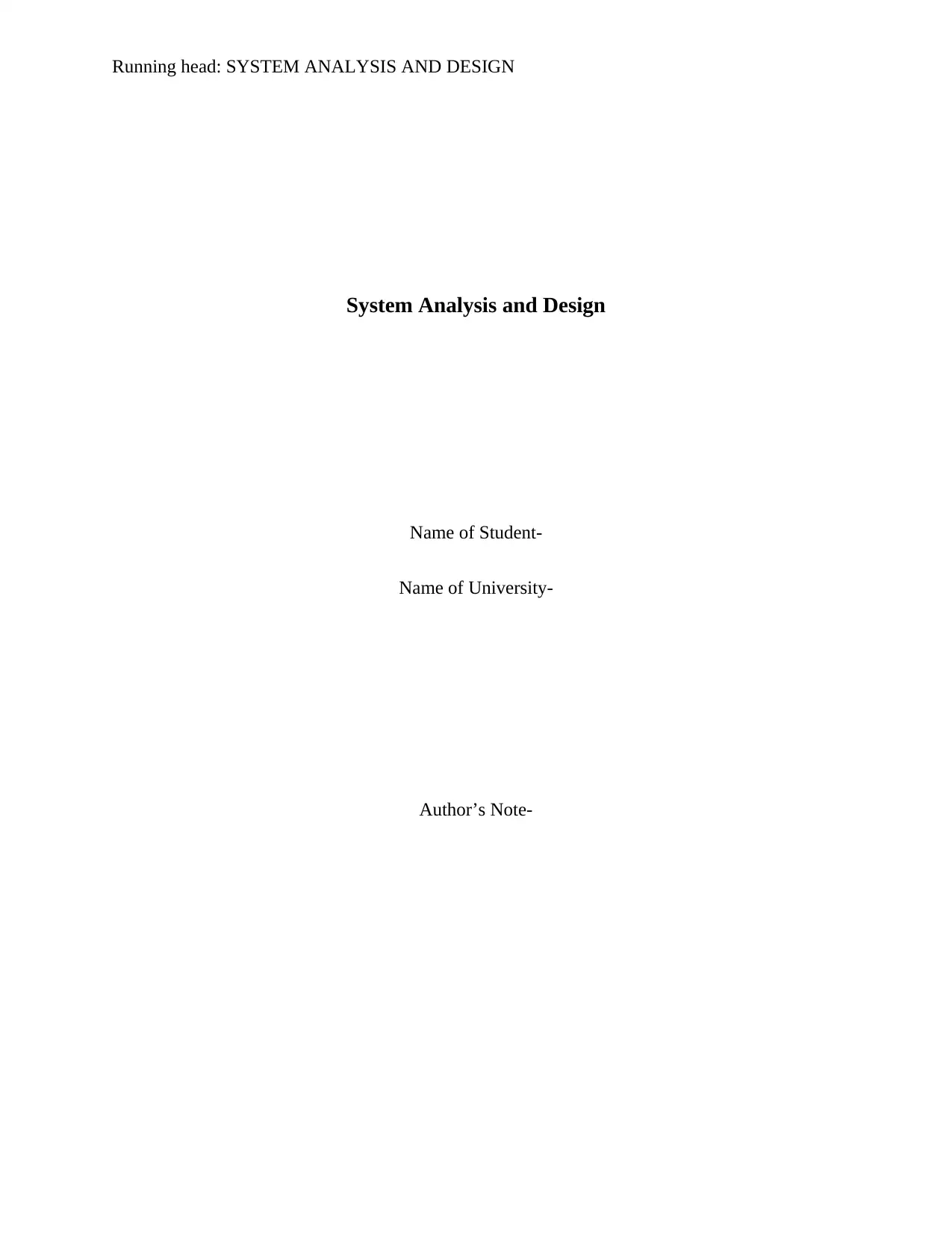
Running head: SYSTEM ANALYSIS AND DESIGN
System Analysis and Design
Name of Student-
Name of University-
Author’s Note-
System Analysis and Design
Name of Student-
Name of University-
Author’s Note-
Paraphrase This Document
Need a fresh take? Get an instant paraphrase of this document with our AI Paraphraser

1SYSTEM ANALYSIS AND DESIGN
Table of Contents
System Development Life Cycle.....................................................................................................1
Class Diagram for membership and facility management system...................................................5
Use Case Diagram for Manager Schedule staff roster.....................................................................7
Use Case Diagram of Member Registers for Class.........................................................................8
Critical Path Method for each Task.................................................................................................8
Bibliography..................................................................................................................................13
Table of Contents
System Development Life Cycle.....................................................................................................1
Class Diagram for membership and facility management system...................................................5
Use Case Diagram for Manager Schedule staff roster.....................................................................7
Use Case Diagram of Member Registers for Class.........................................................................8
Critical Path Method for each Task.................................................................................................8
Bibliography..................................................................................................................................13

2SYSTEM ANALYSIS AND DESIGN
System Development Life Cycle
The main purpose of the SDLC methodology is ensuring the successful implementation
of the system which satisfies the business objectives as well as satisfies the strategic of the
business. There are many goals that SDLC method provides which includes delivering quality
system that helps to meet as well as exceed the expectation of the customer as it is promised and
it is done according to the cost estimate of the project (Aljawarneh, Alawneh and Jaradat 2017).
SDLC methodology also includes providing framework that helps to develop the qulity of the
system that is undertaken in the project and are identifiable process, measurable process as well
as repeatable process.
SDLC methodology helps in establishing a structure of project management that helps to
ensure the system development of the project and this helps the managers to manage the life
cycle of the project. The process of SDLC methodology also helps to identify as well as assign
the responsibilities as well as roles of the parties that are involved (Stark 2015). This mainly
includes the functional as well as technical managers that comes throughout the life cycle of the
system development. The SDLC method helps in ensuring all the requirements of the system
development that are well defined as well as are satisfied.
There are many objective that SDLC method provides. This includes to establish the
management authority properly that provides timely direction, helps in project coordination,
provides approval for developing the system, have control over the project, and finally reviewing
of project. To ensure the accountability of the project also comes under the objective of the
SDLC methodology (Artto, Ahola and Vartiainen 2016). SDLC also has the objective to develop
documents associated with the requirement of the project, and also ensures to maintain the
System Development Life Cycle
The main purpose of the SDLC methodology is ensuring the successful implementation
of the system which satisfies the business objectives as well as satisfies the strategic of the
business. There are many goals that SDLC method provides which includes delivering quality
system that helps to meet as well as exceed the expectation of the customer as it is promised and
it is done according to the cost estimate of the project (Aljawarneh, Alawneh and Jaradat 2017).
SDLC methodology also includes providing framework that helps to develop the qulity of the
system that is undertaken in the project and are identifiable process, measurable process as well
as repeatable process.
SDLC methodology helps in establishing a structure of project management that helps to
ensure the system development of the project and this helps the managers to manage the life
cycle of the project. The process of SDLC methodology also helps to identify as well as assign
the responsibilities as well as roles of the parties that are involved (Stark 2015). This mainly
includes the functional as well as technical managers that comes throughout the life cycle of the
system development. The SDLC method helps in ensuring all the requirements of the system
development that are well defined as well as are satisfied.
There are many objective that SDLC method provides. This includes to establish the
management authority properly that provides timely direction, helps in project coordination,
provides approval for developing the system, have control over the project, and finally reviewing
of project. To ensure the accountability of the project also comes under the objective of the
SDLC methodology (Artto, Ahola and Vartiainen 2016). SDLC also has the objective to develop
documents associated with the requirement of the project, and also ensures to maintain the
⊘ This is a preview!⊘
Do you want full access?
Subscribe today to unlock all pages.

Trusted by 1+ million students worldwide
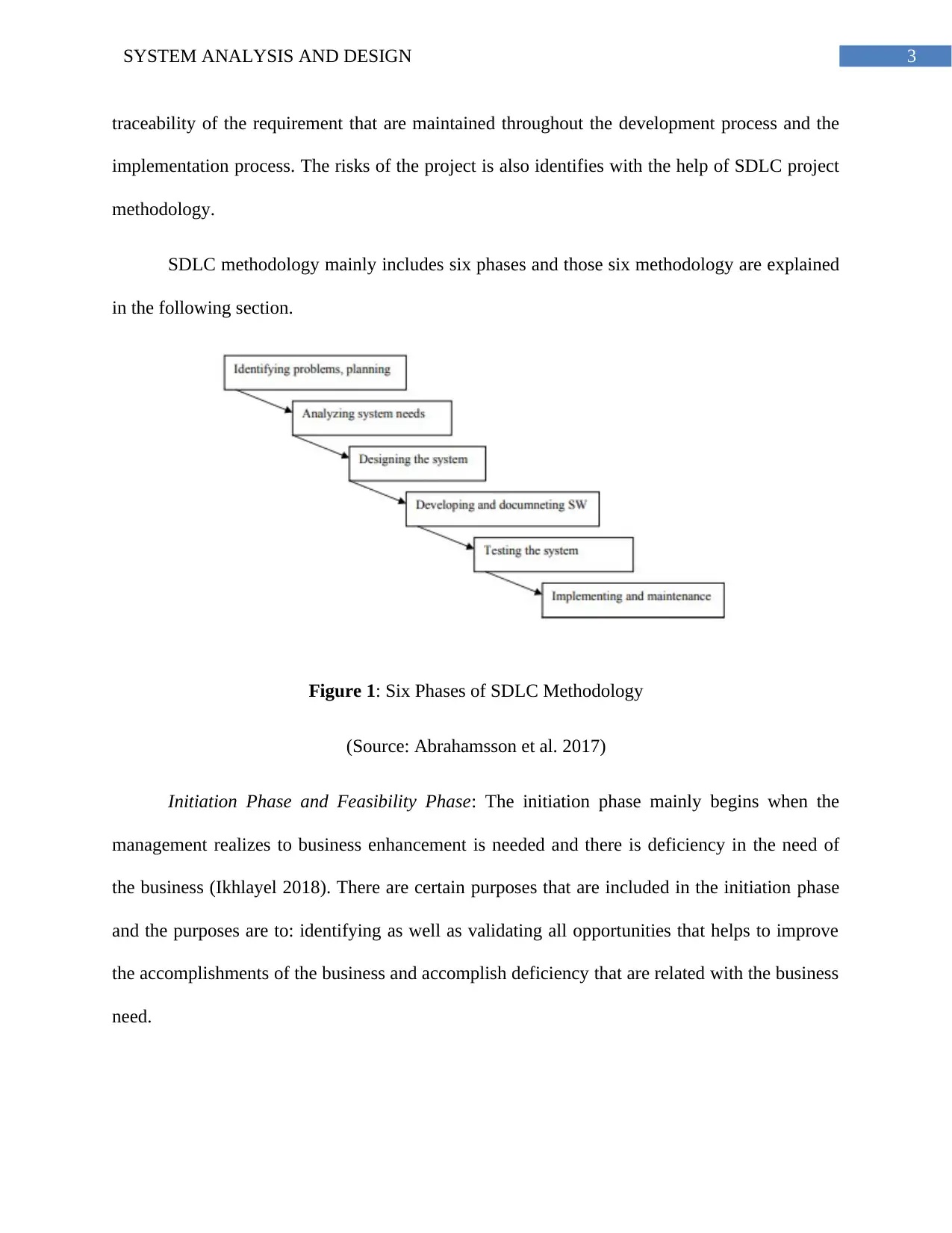
3SYSTEM ANALYSIS AND DESIGN
traceability of the requirement that are maintained throughout the development process and the
implementation process. The risks of the project is also identifies with the help of SDLC project
methodology.
SDLC methodology mainly includes six phases and those six methodology are explained
in the following section.
Figure 1: Six Phases of SDLC Methodology
(Source: Abrahamsson et al. 2017)
Initiation Phase and Feasibility Phase: The initiation phase mainly begins when the
management realizes to business enhancement is needed and there is deficiency in the need of
the business (Ikhlayel 2018). There are certain purposes that are included in the initiation phase
and the purposes are to: identifying as well as validating all opportunities that helps to improve
the accomplishments of the business and accomplish deficiency that are related with the business
need.
traceability of the requirement that are maintained throughout the development process and the
implementation process. The risks of the project is also identifies with the help of SDLC project
methodology.
SDLC methodology mainly includes six phases and those six methodology are explained
in the following section.
Figure 1: Six Phases of SDLC Methodology
(Source: Abrahamsson et al. 2017)
Initiation Phase and Feasibility Phase: The initiation phase mainly begins when the
management realizes to business enhancement is needed and there is deficiency in the need of
the business (Ikhlayel 2018). There are certain purposes that are included in the initiation phase
and the purposes are to: identifying as well as validating all opportunities that helps to improve
the accomplishments of the business and accomplish deficiency that are related with the business
need.
Paraphrase This Document
Need a fresh take? Get an instant paraphrase of this document with our AI Paraphraser
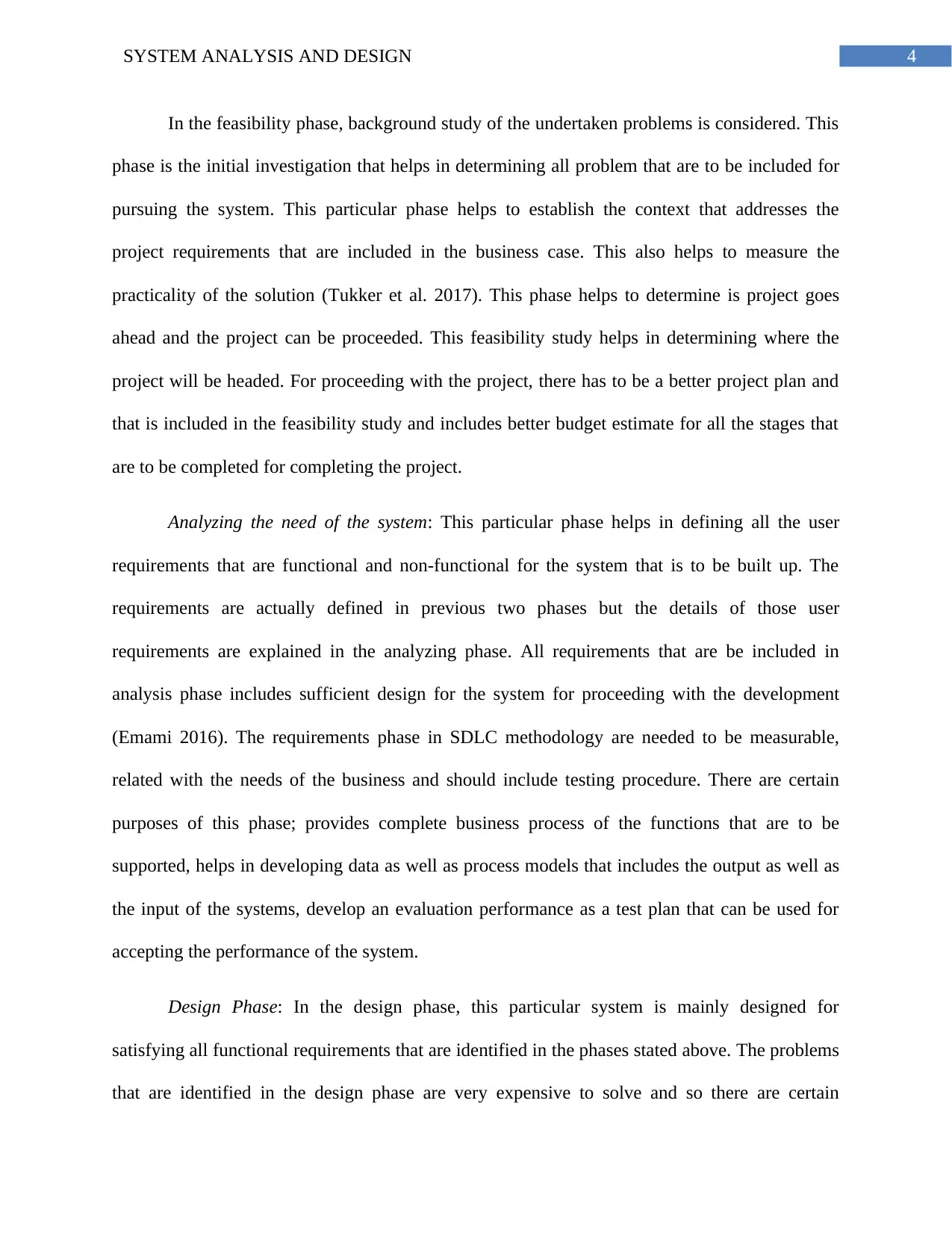
4SYSTEM ANALYSIS AND DESIGN
In the feasibility phase, background study of the undertaken problems is considered. This
phase is the initial investigation that helps in determining all problem that are to be included for
pursuing the system. This particular phase helps to establish the context that addresses the
project requirements that are included in the business case. This also helps to measure the
practicality of the solution (Tukker et al. 2017). This phase helps to determine is project goes
ahead and the project can be proceeded. This feasibility study helps in determining where the
project will be headed. For proceeding with the project, there has to be a better project plan and
that is included in the feasibility study and includes better budget estimate for all the stages that
are to be completed for completing the project.
Analyzing the need of the system: This particular phase helps in defining all the user
requirements that are functional and non-functional for the system that is to be built up. The
requirements are actually defined in previous two phases but the details of those user
requirements are explained in the analyzing phase. All requirements that are be included in
analysis phase includes sufficient design for the system for proceeding with the development
(Emami 2016). The requirements phase in SDLC methodology are needed to be measurable,
related with the needs of the business and should include testing procedure. There are certain
purposes of this phase; provides complete business process of the functions that are to be
supported, helps in developing data as well as process models that includes the output as well as
the input of the systems, develop an evaluation performance as a test plan that can be used for
accepting the performance of the system.
Design Phase: In the design phase, this particular system is mainly designed for
satisfying all functional requirements that are identified in the phases stated above. The problems
that are identified in the design phase are very expensive to solve and so there are certain
In the feasibility phase, background study of the undertaken problems is considered. This
phase is the initial investigation that helps in determining all problem that are to be included for
pursuing the system. This particular phase helps to establish the context that addresses the
project requirements that are included in the business case. This also helps to measure the
practicality of the solution (Tukker et al. 2017). This phase helps to determine is project goes
ahead and the project can be proceeded. This feasibility study helps in determining where the
project will be headed. For proceeding with the project, there has to be a better project plan and
that is included in the feasibility study and includes better budget estimate for all the stages that
are to be completed for completing the project.
Analyzing the need of the system: This particular phase helps in defining all the user
requirements that are functional and non-functional for the system that is to be built up. The
requirements are actually defined in previous two phases but the details of those user
requirements are explained in the analyzing phase. All requirements that are be included in
analysis phase includes sufficient design for the system for proceeding with the development
(Emami 2016). The requirements phase in SDLC methodology are needed to be measurable,
related with the needs of the business and should include testing procedure. There are certain
purposes of this phase; provides complete business process of the functions that are to be
supported, helps in developing data as well as process models that includes the output as well as
the input of the systems, develop an evaluation performance as a test plan that can be used for
accepting the performance of the system.
Design Phase: In the design phase, this particular system is mainly designed for
satisfying all functional requirements that are identified in the phases stated above. The problems
that are identified in the design phase are very expensive to solve and so there are certain
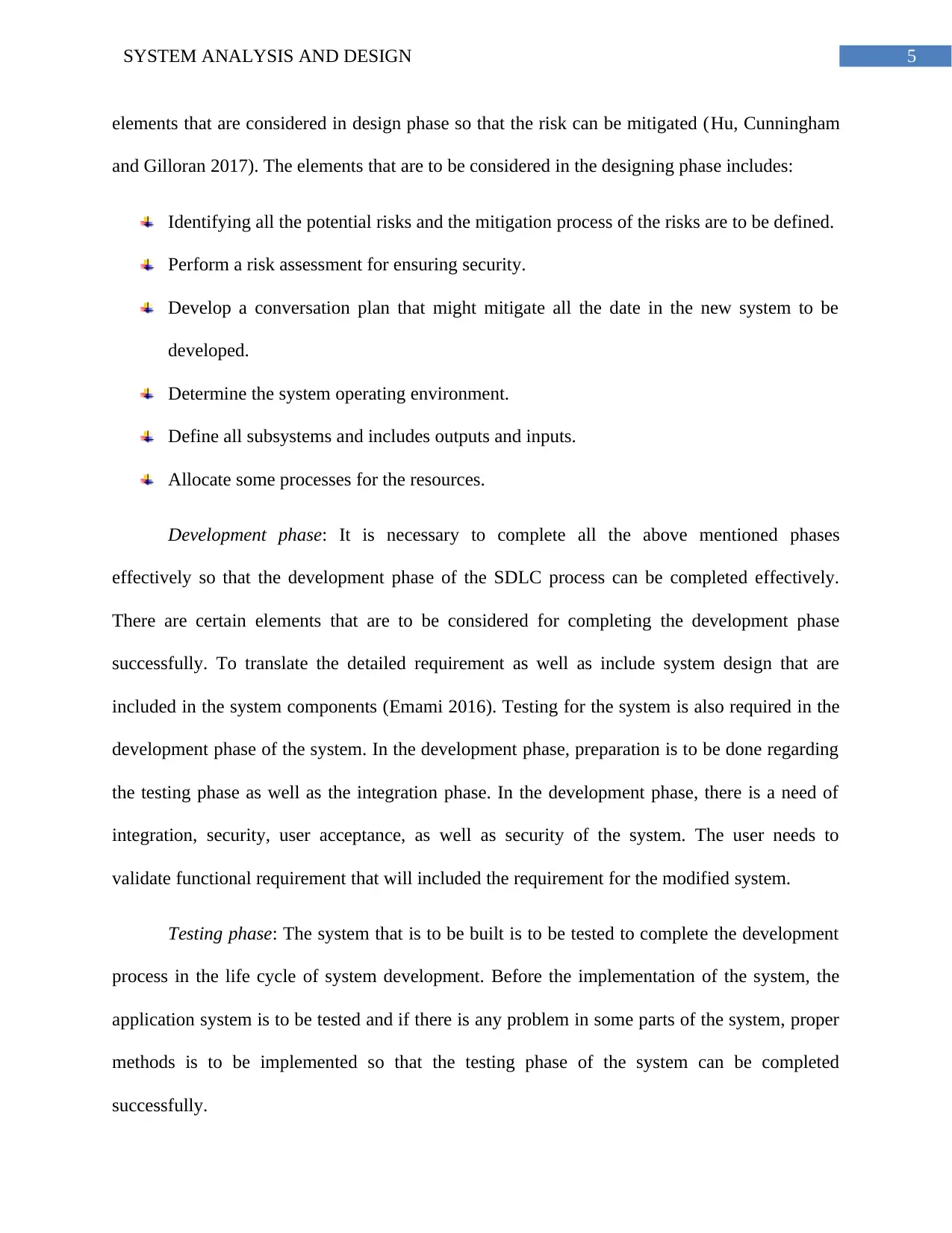
5SYSTEM ANALYSIS AND DESIGN
elements that are considered in design phase so that the risk can be mitigated (Hu, Cunningham
and Gilloran 2017). The elements that are to be considered in the designing phase includes:
Identifying all the potential risks and the mitigation process of the risks are to be defined.
Perform a risk assessment for ensuring security.
Develop a conversation plan that might mitigate all the date in the new system to be
developed.
Determine the system operating environment.
Define all subsystems and includes outputs and inputs.
Allocate some processes for the resources.
Development phase: It is necessary to complete all the above mentioned phases
effectively so that the development phase of the SDLC process can be completed effectively.
There are certain elements that are to be considered for completing the development phase
successfully. To translate the detailed requirement as well as include system design that are
included in the system components (Emami 2016). Testing for the system is also required in the
development phase of the system. In the development phase, preparation is to be done regarding
the testing phase as well as the integration phase. In the development phase, there is a need of
integration, security, user acceptance, as well as security of the system. The user needs to
validate functional requirement that will included the requirement for the modified system.
Testing phase: The system that is to be built is to be tested to complete the development
process in the life cycle of system development. Before the implementation of the system, the
application system is to be tested and if there is any problem in some parts of the system, proper
methods is to be implemented so that the testing phase of the system can be completed
successfully.
elements that are considered in design phase so that the risk can be mitigated (Hu, Cunningham
and Gilloran 2017). The elements that are to be considered in the designing phase includes:
Identifying all the potential risks and the mitigation process of the risks are to be defined.
Perform a risk assessment for ensuring security.
Develop a conversation plan that might mitigate all the date in the new system to be
developed.
Determine the system operating environment.
Define all subsystems and includes outputs and inputs.
Allocate some processes for the resources.
Development phase: It is necessary to complete all the above mentioned phases
effectively so that the development phase of the SDLC process can be completed effectively.
There are certain elements that are to be considered for completing the development phase
successfully. To translate the detailed requirement as well as include system design that are
included in the system components (Emami 2016). Testing for the system is also required in the
development phase of the system. In the development phase, preparation is to be done regarding
the testing phase as well as the integration phase. In the development phase, there is a need of
integration, security, user acceptance, as well as security of the system. The user needs to
validate functional requirement that will included the requirement for the modified system.
Testing phase: The system that is to be built is to be tested to complete the development
process in the life cycle of system development. Before the implementation of the system, the
application system is to be tested and if there is any problem in some parts of the system, proper
methods is to be implemented so that the testing phase of the system can be completed
successfully.
⊘ This is a preview!⊘
Do you want full access?
Subscribe today to unlock all pages.

Trusted by 1+ million students worldwide
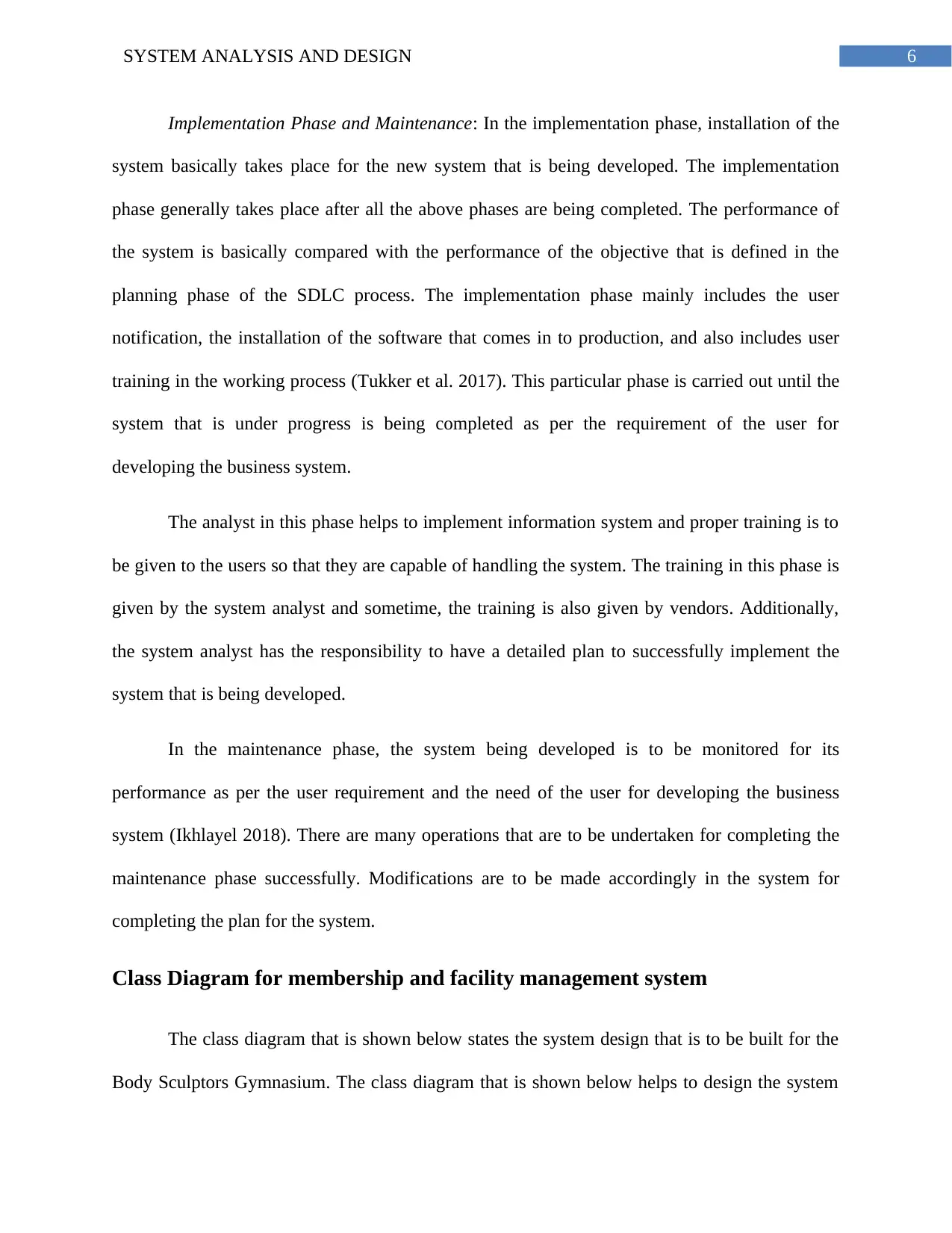
6SYSTEM ANALYSIS AND DESIGN
Implementation Phase and Maintenance: In the implementation phase, installation of the
system basically takes place for the new system that is being developed. The implementation
phase generally takes place after all the above phases are being completed. The performance of
the system is basically compared with the performance of the objective that is defined in the
planning phase of the SDLC process. The implementation phase mainly includes the user
notification, the installation of the software that comes in to production, and also includes user
training in the working process (Tukker et al. 2017). This particular phase is carried out until the
system that is under progress is being completed as per the requirement of the user for
developing the business system.
The analyst in this phase helps to implement information system and proper training is to
be given to the users so that they are capable of handling the system. The training in this phase is
given by the system analyst and sometime, the training is also given by vendors. Additionally,
the system analyst has the responsibility to have a detailed plan to successfully implement the
system that is being developed.
In the maintenance phase, the system being developed is to be monitored for its
performance as per the user requirement and the need of the user for developing the business
system (Ikhlayel 2018). There are many operations that are to be undertaken for completing the
maintenance phase successfully. Modifications are to be made accordingly in the system for
completing the plan for the system.
Class Diagram for membership and facility management system
The class diagram that is shown below states the system design that is to be built for the
Body Sculptors Gymnasium. The class diagram that is shown below helps to design the system
Implementation Phase and Maintenance: In the implementation phase, installation of the
system basically takes place for the new system that is being developed. The implementation
phase generally takes place after all the above phases are being completed. The performance of
the system is basically compared with the performance of the objective that is defined in the
planning phase of the SDLC process. The implementation phase mainly includes the user
notification, the installation of the software that comes in to production, and also includes user
training in the working process (Tukker et al. 2017). This particular phase is carried out until the
system that is under progress is being completed as per the requirement of the user for
developing the business system.
The analyst in this phase helps to implement information system and proper training is to
be given to the users so that they are capable of handling the system. The training in this phase is
given by the system analyst and sometime, the training is also given by vendors. Additionally,
the system analyst has the responsibility to have a detailed plan to successfully implement the
system that is being developed.
In the maintenance phase, the system being developed is to be monitored for its
performance as per the user requirement and the need of the user for developing the business
system (Ikhlayel 2018). There are many operations that are to be undertaken for completing the
maintenance phase successfully. Modifications are to be made accordingly in the system for
completing the plan for the system.
Class Diagram for membership and facility management system
The class diagram that is shown below states the system design that is to be built for the
Body Sculptors Gymnasium. The class diagram that is shown below helps to design the system
Paraphrase This Document
Need a fresh take? Get an instant paraphrase of this document with our AI Paraphraser
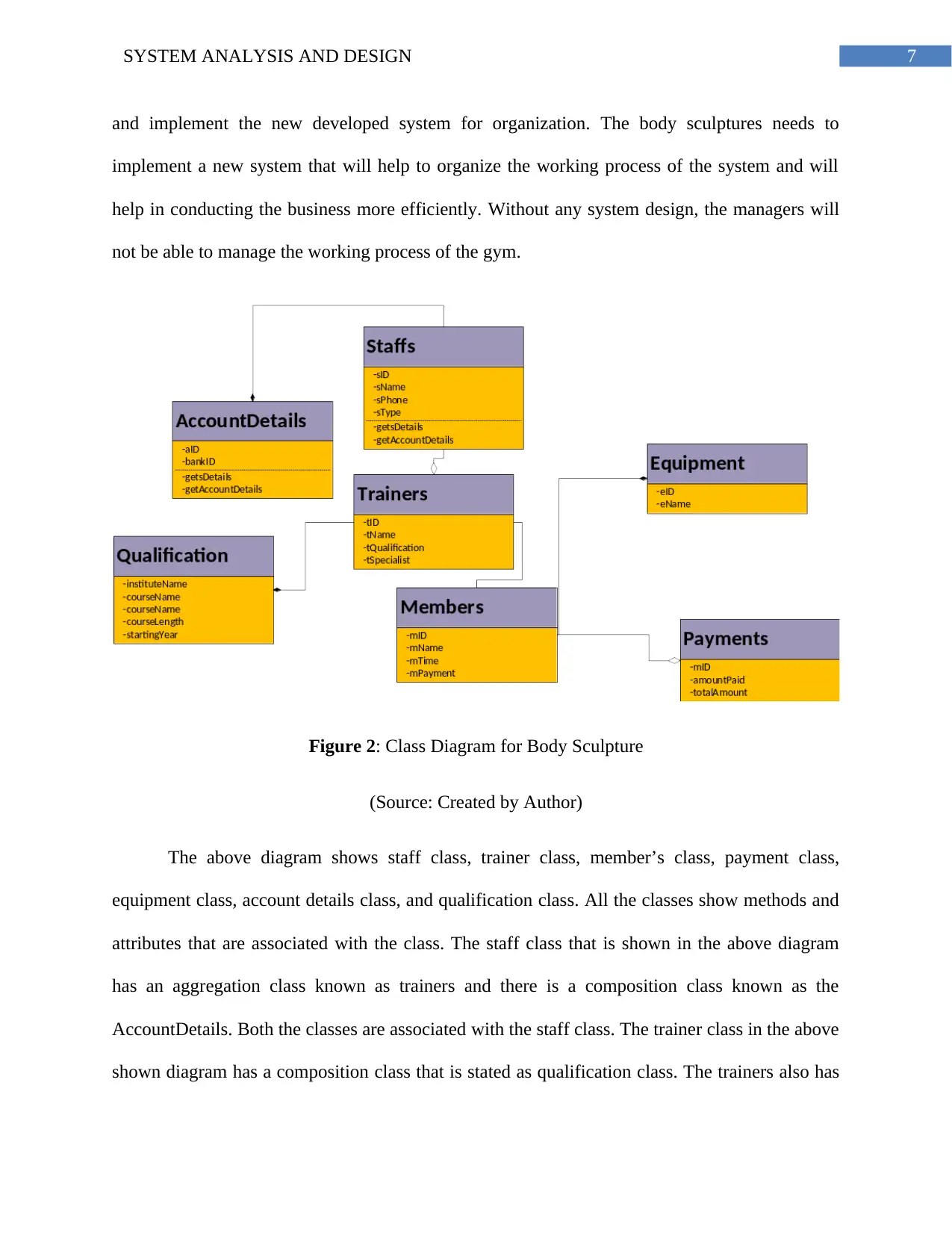
7SYSTEM ANALYSIS AND DESIGN
and implement the new developed system for organization. The body sculptures needs to
implement a new system that will help to organize the working process of the system and will
help in conducting the business more efficiently. Without any system design, the managers will
not be able to manage the working process of the gym.
Figure 2: Class Diagram for Body Sculpture
(Source: Created by Author)
The above diagram shows staff class, trainer class, member’s class, payment class,
equipment class, account details class, and qualification class. All the classes show methods and
attributes that are associated with the class. The staff class that is shown in the above diagram
has an aggregation class known as trainers and there is a composition class known as the
AccountDetails. Both the classes are associated with the staff class. The trainer class in the above
shown diagram has a composition class that is stated as qualification class. The trainers also has
and implement the new developed system for organization. The body sculptures needs to
implement a new system that will help to organize the working process of the system and will
help in conducting the business more efficiently. Without any system design, the managers will
not be able to manage the working process of the gym.
Figure 2: Class Diagram for Body Sculpture
(Source: Created by Author)
The above diagram shows staff class, trainer class, member’s class, payment class,
equipment class, account details class, and qualification class. All the classes show methods and
attributes that are associated with the class. The staff class that is shown in the above diagram
has an aggregation class known as trainers and there is a composition class known as the
AccountDetails. Both the classes are associated with the staff class. The trainer class in the above
shown diagram has a composition class that is stated as qualification class. The trainers also has
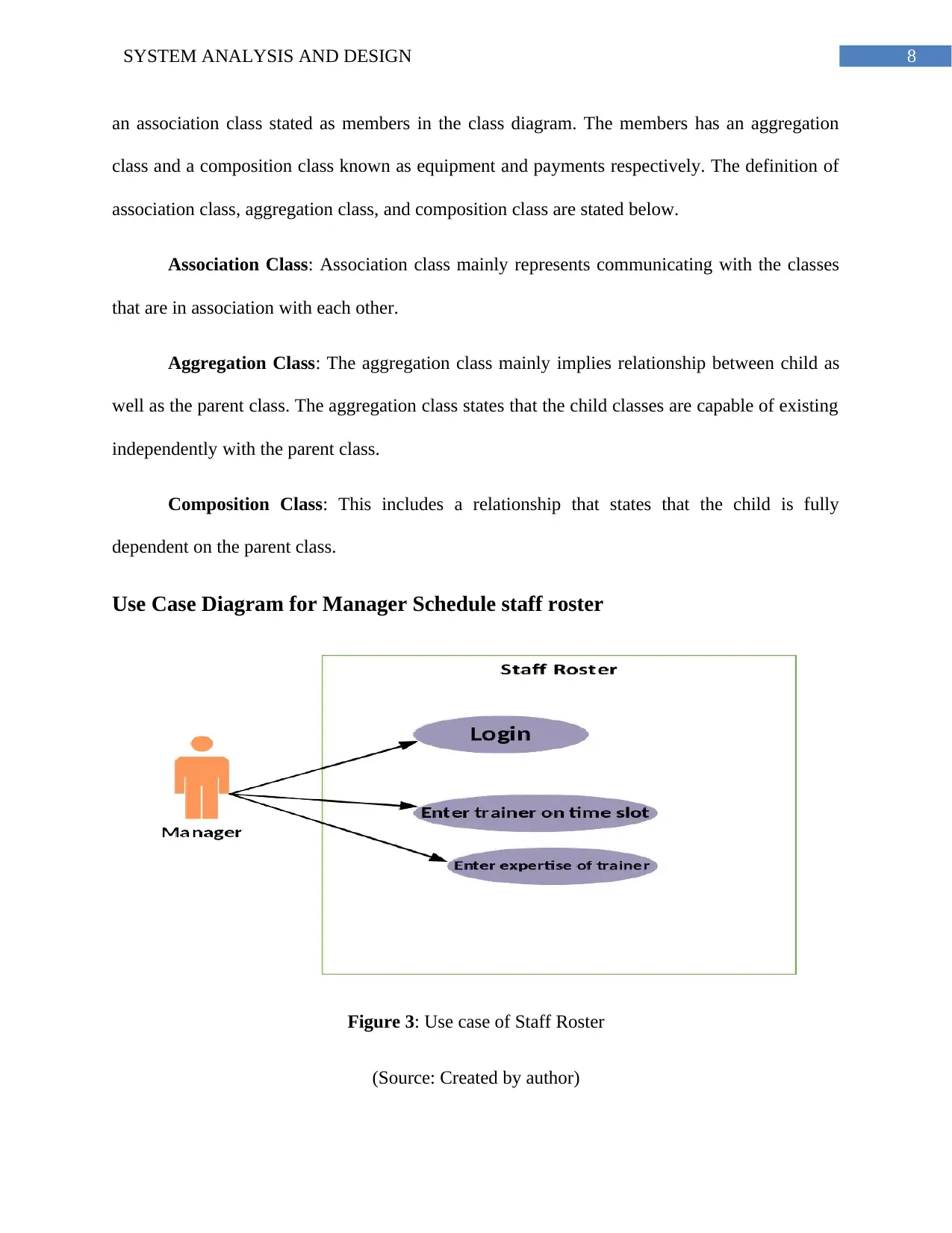
8SYSTEM ANALYSIS AND DESIGN
an association class stated as members in the class diagram. The members has an aggregation
class and a composition class known as equipment and payments respectively. The definition of
association class, aggregation class, and composition class are stated below.
Association Class: Association class mainly represents communicating with the classes
that are in association with each other.
Aggregation Class: The aggregation class mainly implies relationship between child as
well as the parent class. The aggregation class states that the child classes are capable of existing
independently with the parent class.
Composition Class: This includes a relationship that states that the child is fully
dependent on the parent class.
Use Case Diagram for Manager Schedule staff roster
Figure 3: Use case of Staff Roster
(Source: Created by author)
an association class stated as members in the class diagram. The members has an aggregation
class and a composition class known as equipment and payments respectively. The definition of
association class, aggregation class, and composition class are stated below.
Association Class: Association class mainly represents communicating with the classes
that are in association with each other.
Aggregation Class: The aggregation class mainly implies relationship between child as
well as the parent class. The aggregation class states that the child classes are capable of existing
independently with the parent class.
Composition Class: This includes a relationship that states that the child is fully
dependent on the parent class.
Use Case Diagram for Manager Schedule staff roster
Figure 3: Use case of Staff Roster
(Source: Created by author)
⊘ This is a preview!⊘
Do you want full access?
Subscribe today to unlock all pages.

Trusted by 1+ million students worldwide
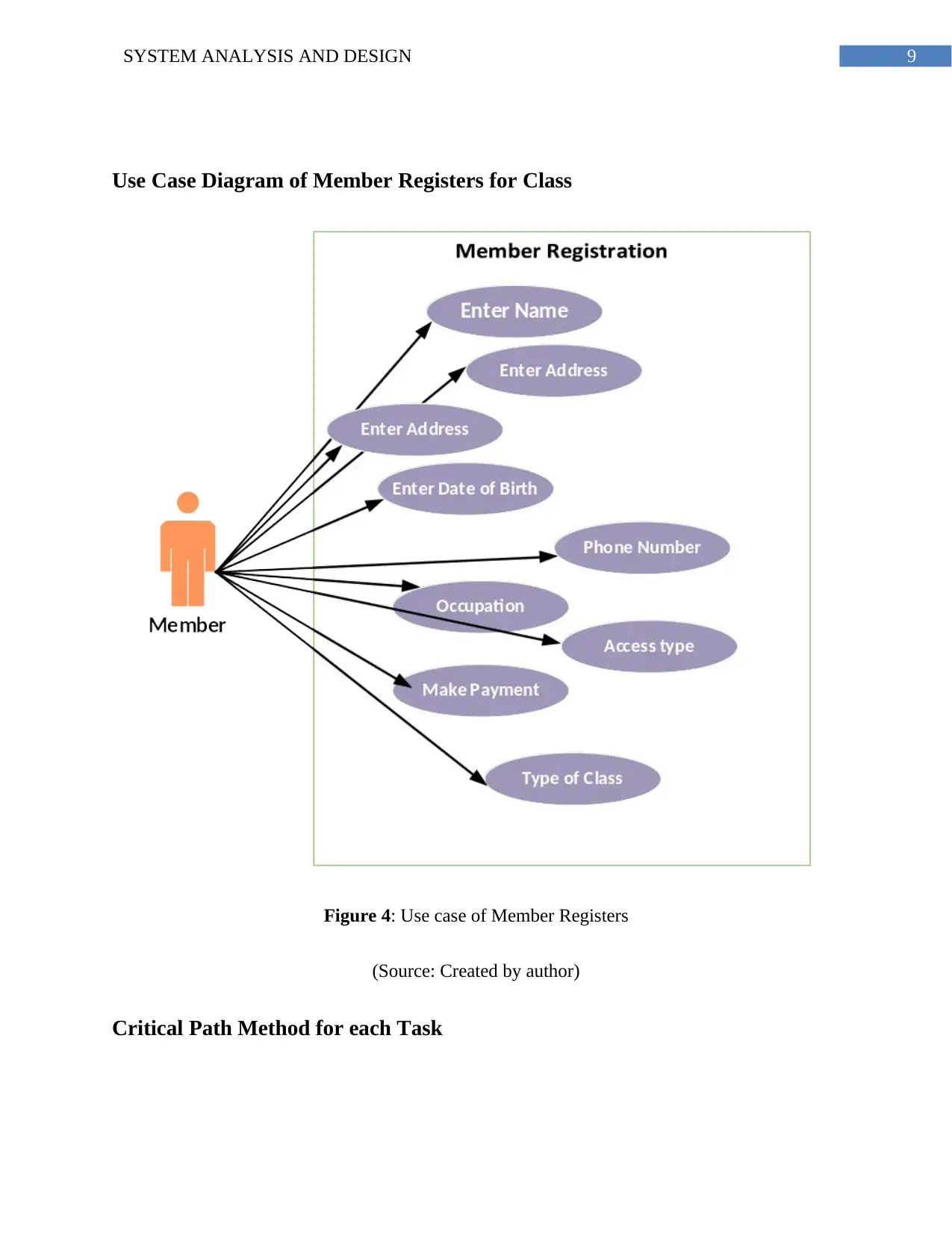
9SYSTEM ANALYSIS AND DESIGN
Use Case Diagram of Member Registers for Class
Figure 4: Use case of Member Registers
(Source: Created by author)
Critical Path Method for each Task
Use Case Diagram of Member Registers for Class
Figure 4: Use case of Member Registers
(Source: Created by author)
Critical Path Method for each Task
Paraphrase This Document
Need a fresh take? Get an instant paraphrase of this document with our AI Paraphraser
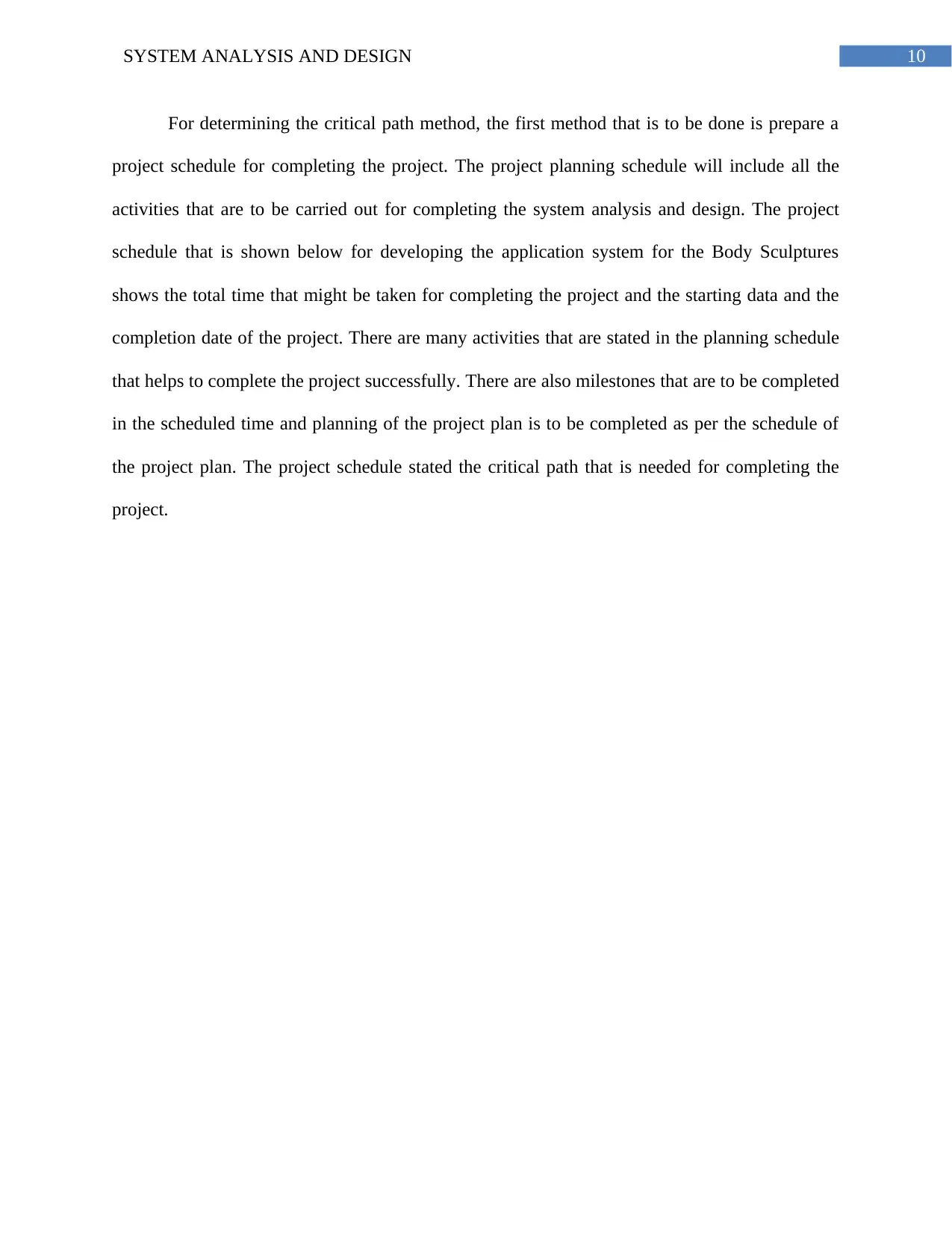
10SYSTEM ANALYSIS AND DESIGN
For determining the critical path method, the first method that is to be done is prepare a
project schedule for completing the project. The project planning schedule will include all the
activities that are to be carried out for completing the system analysis and design. The project
schedule that is shown below for developing the application system for the Body Sculptures
shows the total time that might be taken for completing the project and the starting data and the
completion date of the project. There are many activities that are stated in the planning schedule
that helps to complete the project successfully. There are also milestones that are to be completed
in the scheduled time and planning of the project plan is to be completed as per the schedule of
the project plan. The project schedule stated the critical path that is needed for completing the
project.
For determining the critical path method, the first method that is to be done is prepare a
project schedule for completing the project. The project planning schedule will include all the
activities that are to be carried out for completing the system analysis and design. The project
schedule that is shown below for developing the application system for the Body Sculptures
shows the total time that might be taken for completing the project and the starting data and the
completion date of the project. There are many activities that are stated in the planning schedule
that helps to complete the project successfully. There are also milestones that are to be completed
in the scheduled time and planning of the project plan is to be completed as per the schedule of
the project plan. The project schedule stated the critical path that is needed for completing the
project.

11SYSTEM ANALYSIS AND DESIGN
Figure 5: Project Plan schedule
(Source: Created by author)
Figure 5: Project Plan schedule
(Source: Created by author)
⊘ This is a preview!⊘
Do you want full access?
Subscribe today to unlock all pages.

Trusted by 1+ million students worldwide
1 out of 16
Related Documents
Your All-in-One AI-Powered Toolkit for Academic Success.
+13062052269
info@desklib.com
Available 24*7 on WhatsApp / Email
![[object Object]](/_next/static/media/star-bottom.7253800d.svg)
Unlock your academic potential
Copyright © 2020–2025 A2Z Services. All Rights Reserved. Developed and managed by ZUCOL.





